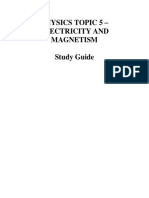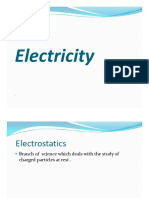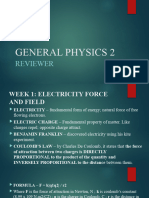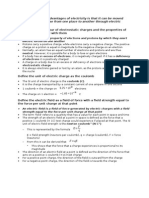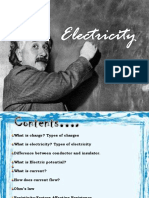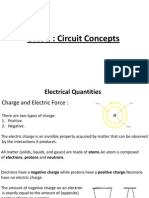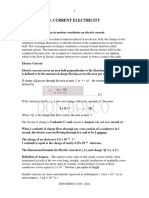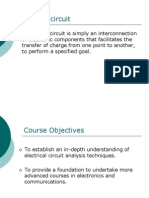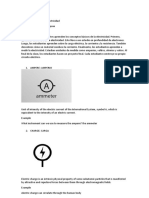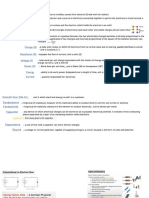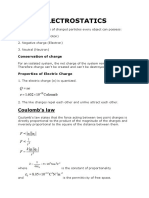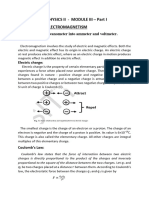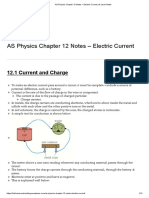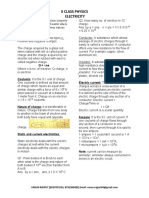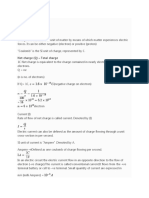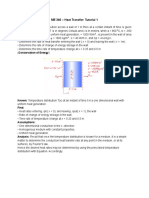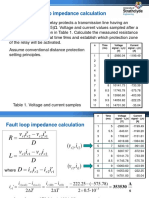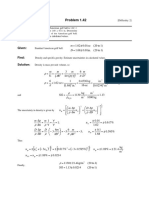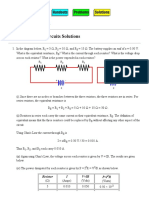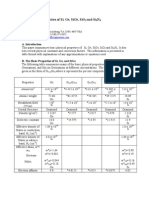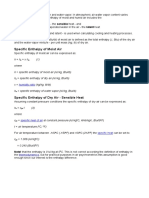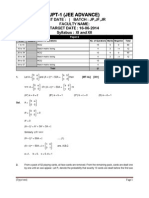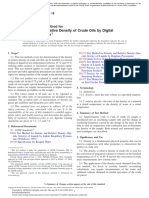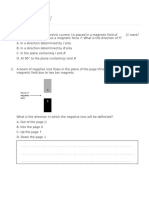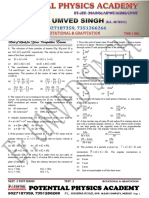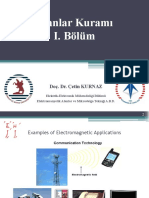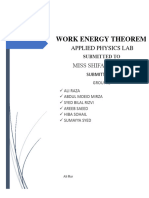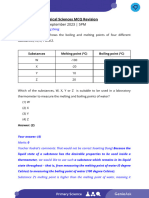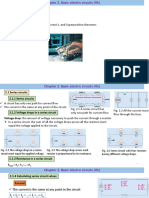Untitled
Untitled
Uploaded by
Joyce LonzagaCopyright:
Available Formats
Untitled
Untitled
Uploaded by
Joyce LonzagaOriginal Description:
Copyright
Available Formats
Share this document
Did you find this document useful?
Is this content inappropriate?
Copyright:
Available Formats
Untitled
Untitled
Uploaded by
Joyce LonzagaCopyright:
Available Formats
Electron Proton Neutron
Negative charge Positive charge Neutral charge
e=-1.6x10-19 C e=1.6x10-19 C mn=1.675x10-27 kg
me=9.11x10-31 kg mp=1.673x10-27 kg
Do not memorize the above!
Law of Charges
- Like charges repel, opposite charges attract.
Electric charge
- The fundamental quantity in electrostatics.
TWO KINDS OF CHARGES
Positive and Negative
Charging by Conduction
A charging method that involves the contact of a charged object to a neutral object.
Charging by Induction
a charging method that charges an object without actually touching the object to any other
charged object.
Coulomb's Law (const “k”)
- The magnitude of the electric forces between two point charges is directly proportional
to the product of the charges and inversely proportional to the square of the distance
between them. Electrostatic force, also called Coulomb’s force, is defined as the amount
and direction of attraction and repulsion between two charged bodies.
- If both charges have opposite signs, the force will be attractive, otherwise repulsive.
Electric Field ( “E” , units : N/C “Newton/Coulomb”)
- Is a region of space in which an electric charge experiences a force.
Electric Flux ( “Φ” , units : N.m2/C )
- Is the measure of the “flow” of an electric field through a surface. Is the product of
magnitude of the electric field (E) and the surface area (A) perpendicular to the field.
Gauss Law
- The total of the electric flux out of a closed surface is equal to the charge enclosed
divided by the permittivity.
Insulator (Dielectric materials)
- Materials that hold their electrons very tightly.
Conductor
- Materials that hold their electrons loosely, that can easily move through them.
Electron transfer is the gain or loss of electrons.
Ionization is the process of removing one or more electrons from an atom.
Anion is an atom that has gained one or more electrons.
Electric potential (“V” , units J Joules) is the potential energy (denotation “ΔPE”) per unit
charge.
Potential energy is converted to kinetic energy
Conservative force
PE is used to denote electric potential energy
Voltage
- Is the common name for potential difference. Whenever voltage is quoted, it is
understood to be the potential difference between the two points.
Capacitor
- Is a system that stores energy in the form of an electric field. A capacitor consists of a
pair of metal plates separated by air or other insulating material.
Capacitance
Unit of Capacitance
1 Coulomb/V = 1 Farad
1 farad = 1C/V
Dielectric Breakdown
- Is a partial ionization that permits conduction through a material that is supposed to
insulate.
Time constant
t=RC; t=time in seconds ; R=resistance in ohms ; C=capacitance in Farad
Circuit diagram
- Is a graphical/simplified representation of an actual electric circuit.
Current
- Is the rate at which charge flows past a point on a circuit. The current in a circuit can be
determined by the quantity of charge Q passing through a cross section of a wire in a
time t can be measured.
Unit of Resistance is ohm “Ω”.
Unit of Potential is volt “V”.
Unit of Charge is coulomb “C”.
Electric current (“A” , “amp” , ampere)
- Is the amount of charge flowing through a specified area, per unit time.
Complete circuit
- Is a conducting loop that provides a continuous current carrying path. Must contain a
source of electromotive force (emf). The SI unit of emf is volt.
Electric power (“W” , watt)
- The rate at which work is done to maintain an electric current is given by the product of I
and the potential difference “V”.
Electric circuit
- Is a closed conducting path for an electron flow.
Voltage
- Must be connected across the circuit to produce current.
Direct Current (DC)
- The current direction (not magnitude) in a circuit does not change with time.
Alternating Current (AC)
- The current direction (often also the magnitude) in a circuit changes with time.
Resistor
- Is an electrical component that limits or regulates the “flow” of electrical current in an
electronic circuit.
Ohmmeter
- Is an instrument used to measure resistance.
Junction/branch point
- Is a point where three or more conductors meet.
Kirchhoff's Junction rule
- At any junction point, the sum of all currents entering the junction must equal the sum of
all currents leaving the junction.
Voltmeter is an instrument used to measure the potential difference in a circuit.
Ammeter is an instrument used to measure the electric current in a circuit.
Ohmmeter is an instrument used to measure the resistance in a circuit.
Rate quantities in physics:
Velocity
- The rate at which an object changes its position.
Acceleration
- The rate at which an object changes its velocity.
Power
- The rate at which work is done on an object.
You might also like
- Engineering Formulas Book PDFDocument83 pagesEngineering Formulas Book PDFmititei100% (2)
- EST 130 BEE Module 1Document94 pagesEST 130 BEE Module 1Gayathri VijayachandranNo ratings yet
- Electrostatics Is The Study of Stationary Electric Charges and All The Effects They ProduceDocument53 pagesElectrostatics Is The Study of Stationary Electric Charges and All The Effects They ProduceNo PainNo ratings yet
- Unit-1 2Document20 pagesUnit-1 2Akhilesh Kumar MishraNo ratings yet
- Physics Topic 5 Study GuideDocument8 pagesPhysics Topic 5 Study GuideSai 0235No ratings yet
- 5.1 Electric Charge: CoulombsDocument5 pages5.1 Electric Charge: Coulombsfazeelm24No ratings yet
- ElectricityDocument87 pagesElectricityayushk68863No ratings yet
- Electricitymagnetism 1218551510898393 8Document57 pagesElectricitymagnetism 1218551510898393 8Halima Labagani AbdulNo ratings yet
- Concept of Current:: Electrical EngineeringDocument7 pagesConcept of Current:: Electrical EngineeringRam VigneshNo ratings yet
- Unit 02 - 1Document3 pagesUnit 02 - 1raghg2005No ratings yet
- General Physics 2 ReviewerDocument22 pagesGeneral Physics 2 Reviewercharydel.oretaNo ratings yet
- JNTUA JNTUH JNTBasic Electrical and Electronics Engineering BEEE NoteDocument93 pagesJNTUA JNTUH JNTBasic Electrical and Electronics Engineering BEEE Notejiyija2465No ratings yet
- Basic Concepts of ElectronicsDocument7 pagesBasic Concepts of ElectronicsmackoypogiNo ratings yet
- Direct Current and PowerDocument5 pagesDirect Current and PowerElizabeth AnyegaNo ratings yet
- Electricity at HomeDocument10 pagesElectricity at HomeWilliam HaNo ratings yet
- Current ElectricityDocument5 pagesCurrent ElectricityKamesh RajputNo ratings yet
- 02 Lecture (Electromagnetism)Document71 pages02 Lecture (Electromagnetism)reduanulalamhridoyNo ratings yet
- Class 1Document32 pagesClass 1Bhargav LahonNo ratings yet
- Basic Electrical and Electronics EngineeringDocument51 pagesBasic Electrical and Electronics EngineeringJayniti Kumari100% (1)
- Electricity (Main)Document16 pagesElectricity (Main)Sarthak KapoorNo ratings yet
- BE Circuit ConceptsDocument15 pagesBE Circuit ConceptsVivekPatelNo ratings yet
- Current Electricity (Edited)Document41 pagesCurrent Electricity (Edited)paperNo ratings yet
- 5.1: Electrical DistributionDocument31 pages5.1: Electrical DistributionShuhada SamsudinNo ratings yet
- Cse-Lec 01Document47 pagesCse-Lec 01Zain Ul AabidinNo ratings yet
- Introduction To Electrical Maintenance: - Dr.K.Siva Agora Sakthivel Murugan - VTC, Al-Seeb, OmanDocument45 pagesIntroduction To Electrical Maintenance: - Dr.K.Siva Agora Sakthivel Murugan - VTC, Al-Seeb, OmanSiva KathikeyanNo ratings yet
- General Physics 2 (3 Quarter) : Prepared by Engr. Jackielou D. Decena, Ms EceDocument55 pagesGeneral Physics 2 (3 Quarter) : Prepared by Engr. Jackielou D. Decena, Ms EceSpace Monkey100% (1)
- Volt Curr ResisDocument12 pagesVolt Curr ResisVíctor Manuel Villegas EscobarNo ratings yet
- Ib Physics HL Chapter 5 and 10 and 11 Electricity and MagnetismDocument28 pagesIb Physics HL Chapter 5 and 10 and 11 Electricity and MagnetismAnastasia VergouNo ratings yet
- The Basics of Electricity CompleteDocument9 pagesThe Basics of Electricity CompleteAlejandroDuranNo ratings yet
- Definition of Terms SummaryDocument3 pagesDefinition of Terms SummaryWenith YapanaNo ratings yet
- Electricity and MagnetismDocument29 pagesElectricity and MagnetismNashrul HaqNo ratings yet
- Electric Circuit TheoryDocument6 pagesElectric Circuit TheoryPaula ZofioNo ratings yet
- Chapter1 FundamentalDocument96 pagesChapter1 FundamentalfrankieyiiNo ratings yet
- DefinitionsDocument7 pagesDefinitionsAnoushka PradhanNo ratings yet
- w2 BasicsDocument26 pagesw2 Basicsmurat aydoganNo ratings yet
- Electricity and MagnetismDocument20 pagesElectricity and MagnetismMido YoussefNo ratings yet
- Introduction To Electrical EngineeringDocument55 pagesIntroduction To Electrical Engineeringksreddy2002No ratings yet
- 1.1 Electrical Quantities and Units: Circuit, and Each Component of The Circuit Is Known As An ElementDocument19 pages1.1 Electrical Quantities and Units: Circuit, and Each Component of The Circuit Is Known As An ElementAbrha FtsumNo ratings yet
- Intro To Electrical EngineeringDocument52 pagesIntro To Electrical EngineeringAerdia100% (1)
- Basic Electrical Engineering (BEEE101L) : Presented byDocument22 pagesBasic Electrical Engineering (BEEE101L) : Presented byAsh wanthNo ratings yet
- Electric Charge-It Determines The: Gen. Physics 2 Lecture NotesDocument3 pagesElectric Charge-It Determines The: Gen. Physics 2 Lecture NotesDaryllNo ratings yet
- Electrostatics: Coulomb's LawDocument16 pagesElectrostatics: Coulomb's LawTafazzul Hazqueel100% (1)
- ABE 112 ReviewerDocument2 pagesABE 112 ReviewermikotaktNo ratings yet
- Applied Physics II - Module III - Part IDocument17 pagesApplied Physics II - Module III - Part Ikannankarthi3002No ratings yet
- Capacitor & Current Electricity - Short NotesDocument5 pagesCapacitor & Current Electricity - Short NotesAbdul LatheefNo ratings yet
- Ge2151 Beee NotesDocument143 pagesGe2151 Beee NotesNanda Subramanian100% (1)
- Coulombs Law, Gauss Law, Electric PotentialDocument50 pagesCoulombs Law, Gauss Law, Electric Potentialbryan valle100% (1)
- CoulombsDocument47 pagesCoulombsTrishia LimpinNo ratings yet
- Physics: AssignmentDocument27 pagesPhysics: AssignmentElakkiya Elakkiya0% (1)
- As Physics Chapter 12 Notes - Electric Current - A Level NotesDocument11 pagesAs Physics Chapter 12 Notes - Electric Current - A Level NotesRakotoarison Louis FrederickNo ratings yet
- ElectrostaticsDocument4 pagesElectrostaticsSoundarrajan RajanNo ratings yet
- 3544 FdocDocument8 pages3544 FdocDean SeepaneNo ratings yet
- X Class Physics ElectricityDocument7 pagesX Class Physics ElectricityPaarth BansalNo ratings yet
- IB CHAPTER 5 - Electricity and MagnetismDocument67 pagesIB CHAPTER 5 - Electricity and Magnetismkostas100% (1)
- Electrical Energy and PowerDocument8 pagesElectrical Energy and Powerrudiskw456No ratings yet
- ELECTRICITYDocument5 pagesELECTRICITYminakshi tiwariNo ratings yet
- Chapter 1 IntroductionDocument12 pagesChapter 1 IntroductionHazem DoufeshNo ratings yet
- Physics: AssignmentDocument27 pagesPhysics: AssignmentElakkiya ElakkiyaNo ratings yet
- PP 1Document33 pagesPP 1Vishnu IngleNo ratings yet
- ME 346 (S3) Tutorial 1 - SolutionsDocument18 pagesME 346 (S3) Tutorial 1 - SolutionsdivyanshuNo ratings yet
- Fault Loop Impedance Calculation: ExampleDocument4 pagesFault Loop Impedance Calculation: Examplebilawal shakirNo ratings yet
- Eksperiman FizikDocument26 pagesEksperiman FizikNUR BATRISYIA AMALYANo ratings yet
- Questions For Discussion and Analysis: (Do Not Rewrite The Questions)Document35 pagesQuestions For Discussion and Analysis: (Do Not Rewrite The Questions)Kevin MorrisNo ratings yet
- Physics 12th Electrostatics QuestionsDocument23 pagesPhysics 12th Electrostatics QuestionsPierre McCarthyNo ratings yet
- Earthing Calculation: Va Tech WabagDocument8 pagesEarthing Calculation: Va Tech Wabaghari sudhanNo ratings yet
- Problem 1.42 PDFDocument1 pageProblem 1.42 PDFKauê BrittoNo ratings yet
- PHYS 1100 DC Circuits SolutionsDocument14 pagesPHYS 1100 DC Circuits SolutionsYihun TsegayeNo ratings yet
- The General Properties of Si, Ge, SiGe, SiO2 and Si3N4Document5 pagesThe General Properties of Si, Ge, SiGe, SiO2 and Si3N4AlaSamSomNo ratings yet
- DYNAMICS OF MACHINERY: Kinetostatic Analysis of The Stephenson III Six-Bar Linkage With A Spring and A DamperDocument157 pagesDYNAMICS OF MACHINERY: Kinetostatic Analysis of The Stephenson III Six-Bar Linkage With A Spring and A DamperThanh Nguyen100% (1)
- FLUID-MECHANICSDocument49 pagesFLUID-MECHANICSBong DuterteNo ratings yet
- Moist Air Is A Mixture of Dry Air and Water VaporDocument10 pagesMoist Air Is A Mixture of Dry Air and Water Vaporlab100% (1)
- Recap On CH - 1 of G - 11 With Teacher' SguideDocument5 pagesRecap On CH - 1 of G - 11 With Teacher' SguideKhin Khin ThanNo ratings yet
- ASTM D4052 - 11 - Standard Test Method For Density, Relative Density, API Gravity of Liquids by Digital Density MeterDocument8 pagesASTM D4052 - 11 - Standard Test Method For Density, Relative Density, API Gravity of Liquids by Digital Density Meternam88No ratings yet
- Conversion FactorsDocument4 pagesConversion FactorsJim Goetz75% (4)
- JEE Advanced 2016 Mock Test PaperDocument62 pagesJEE Advanced 2016 Mock Test PaperJinish RaiyarelaNo ratings yet
- Battery Vision 6FM134-XDocument2 pagesBattery Vision 6FM134-XJoko SusiloNo ratings yet
- PowerPoint Area of A ParallelogramDocument9 pagesPowerPoint Area of A Parallelogramo00547890No ratings yet
- Week 01 Motion WorksheetDocument4 pagesWeek 01 Motion WorksheetKrystian BonghanoyNo ratings yet
- D5002 16 PDFDocument6 pagesD5002 16 PDFJOSENo ratings yet
- Chapter 5Document44 pagesChapter 5Hafizszulfeyzul FeyzulNo ratings yet
- 41 MarksDocument21 pages41 Marksibrahim fadelNo ratings yet
- Neet - 2 Test Series Rotational Motion and Gravitation 1 FinalDocument4 pagesNeet - 2 Test Series Rotational Motion and Gravitation 1 Finalumved singh yadavNo ratings yet
- Alanlar Kuramı I. Bölüm: Doç. Dr. Çetin KURNAZDocument22 pagesAlanlar Kuramı I. Bölüm: Doç. Dr. Çetin KURNAZSimon Se7enNo ratings yet
- Work Energy Theorem Lab Report 3Document7 pagesWork Energy Theorem Lab Report 3ali razaNo ratings yet
- Xuanting Dong P6-AM September Physical Sciences MCQ Revision FeedbackDocument8 pagesXuanting Dong P6-AM September Physical Sciences MCQ Revision FeedbackKudrat SharmaNo ratings yet
- 11.3 Ws Trigonometric FunctionsDocument7 pages11.3 Ws Trigonometric FunctionsAadil ShakulNo ratings yet
- Design of A Squirrel Cage Induction Motor: Data - SheetDocument7 pagesDesign of A Squirrel Cage Induction Motor: Data - SheetSovanSurNo ratings yet
- ElectricityAndElectromagnetismI Lecture 03 NotesDocument33 pagesElectricityAndElectromagnetismI Lecture 03 NotesTran Sy LoiNo ratings yet




